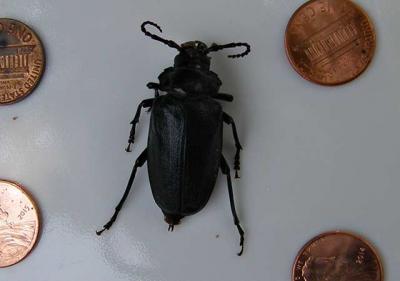Nature Notes: Dog Days’ Night Music

It’s been hot as Hades and unrelentingly humid. In other words, the air is almost filled to capacity with moisture, but not the kind that produces rain. Plants are wilting and songbirds are trying to stay cool by lying low and not singing.
Birdsongs may be few and far between, but the slack is taken up by singing insects. There is one insect that loves these dog days, so much that it is called the dog-day cicada. You will probably never see one, but you can’t miss the song. It’s the loud whine of a buzz saw, most commonly heard during the day shortly before noon.
It is closely related to the 17-year cicada and its pupal cast is a light brown replica of the larva that grew into it, but is empty. It’s about an inch long and is usually seen hanging upside down on the bottom surface of a leaf. I’ve seen two thus far within the last week. Before emergence, the larvae live in the ground and eat pine roots. I have a lot of white pines in the yard, which might explain their presence. Apparently, they are not found in solely deciduous forests.
If there are dog-day cicadas around, you’re liable to see a cicada killer or two — slender, sleek black wasps with yellow markings a couple of inches long. They cruise the edges of vegetation in a fast beeline flight, landing every once in a while to poke around in a nook or cranny, presumably looking for a cicada to take back to their nests. A few females get together and dig a tunnel into soil, then scoop out two or three cells where the cicadas, once stung and carried to the nest, are deposited before an egg is laid. The egg hatches out and the larva subsists on the fat cicada.
The cicada killer is one of the longest in the insect order Hymenoptera (ants, bees, wasps, hornets, etc.), and it doesn’t waste its sting on humans. A larger insect among those in my small Noyac yard is the tooth-necked longhorn beetle, a beautiful ebony flack beetle half as wide as it is long and flattish. I have found two thus far and have one for safekeeping. It is one of the most injurious insects of them all — not the adult, mind you, but the larvae hatched from the eggs. They eat the roots of oaks and other hardwood species.
Oak trees die limb by limb slowly over a period of time, as a very large chestnut oak in my neighbor’s yard has been doing. The adult emerges from the ground to mate. You probably won’t see this beetle, but you might hear one flying on a hot night then crashing into the window of a lighted room with a loud thud.
Maybe the most beneficial beetle in my yard is the black-spotted ladybug, not a bug but a true Coleopteran. I have one hanging around the tops of my tall goldenrods, which have yet to bloom but are already four feet high. Why is it there? The leaves and stem are covered with orange aphids. At 20 or so a day, it has enough on site to last through August. Both adults and larvae, mostly black with yellow markings, feed on aphids. At first the adult was on a neighboring tiger lily chowing down on white cottony aphids. It apparently prefers the ones without the floss.
Aphids, like Argentine ants, are among the most abundant of insects. Thus, there are usually enough to feed the ladybird beetles in the yard, but also the snowy tree crickets, which are rarely seen but regularly heard, especially on warm August nights. They’ve been stridulating their monotonous songs for hours on end since the last week in July. Count the number of beats in 13 seconds and add 40 and you have the ambient temperature within a few degrees Fahrenheit. I’ve used the formula several times over the years and it works.
The other night singer in my yard is the katydid. “Katy did, Katy didn’t” goes the common refrain. Their calls are not as temperature-dependent as those of the snowy tree cricket. Come fall when the weather cools, they become long and drawn out, like the refrain on an LP record when the turntable drive begins to slip. Both sexes make the calls and it is thought that prior to mating they call to each other.
So much for the stridulating insects and those that make noise with their wings in flight. The moths are almost totally silent, as are the butterflies. Wouldn’t you know it, the most common butterfly in town is the cabbage white from Eurasia. It is doing quite well while most of the native butterflies are languishing.
The monarch is one of those last. I have yet to see a monarch this summer. On the other hand, milkweeds, the monarchs’ host of choice, have been flourishing locally.
Alex and Stella Miller of East Hampton were driving about on Friday and saw two monarchs, one in Wainscott and one in Springs near Three Mile Harbor. Among my acquaintances, Vicki Bustamante holds the record to date, at eight. My friend Peter Dermody, a geologist and hydrologist in western Southampton, tags monarchs as part of a nationwide recovery effort, but has yet to see one this year.
To step away from the insects for a moment, Karilyn Jones called on her way into town today — she saw a groundhog in the field on the south side of Montauk Highway across from the Poxabogue Golf Course, where Sagaponack meets Wainscott. How much wood could a woodchuck chuck if a woodchuck could chuck wood? K K K Katy, that’s all folks.
Larry Penny can be reached via email at [email protected].
